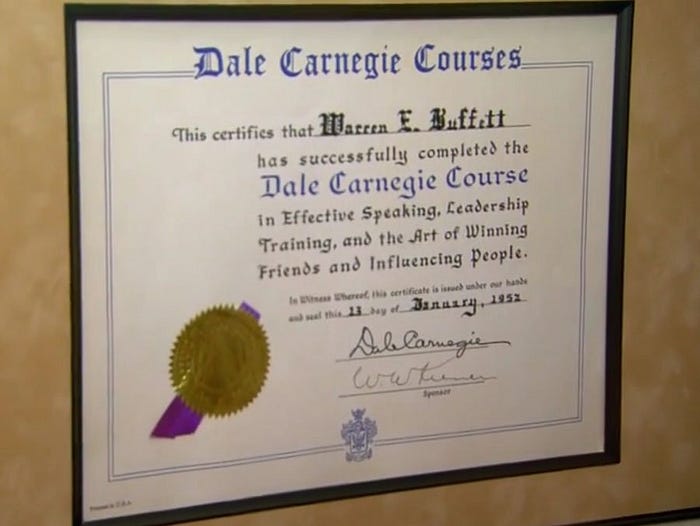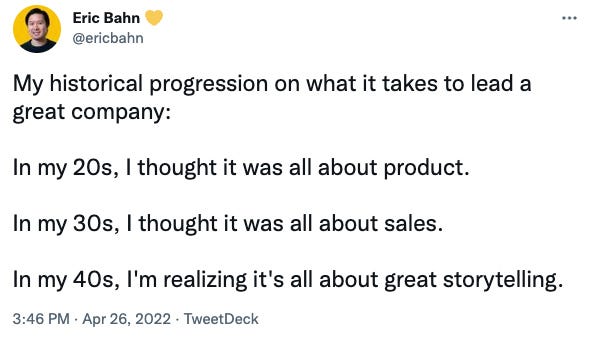Be a Master Storyteller
Warren Buffett is probably the most successful businessman in the world. He started investing his newspaper delivery money at age fourteen, soon was investing other people’s money, and today he manages over $950 billion worth of assets via his holding company, Berkshire Hathaway.
If you walk into Warren Buffett’s office in Omaha today, you might expect to see his framed diploma from Columbia Business School on the wall. But you won’t. Instead, you’ll see a faded 1952 certificate for completing a $100 Dale Carnegie course on public speaking, proudly displayed.

Buffett believes that learning how to be good at speaking and presenting changed his life, perhaps even more than his MBA. “In graduate school you learn all this complicated stuff, but what’s really essential is being able to get others to follow your ideas,” he says.
And so it is for entrepreneurs everywhere. To be a successful startup founder, you must have the ability to tell a crisp, clear, and compelling story about what your startup does, and why it matters.
Many people think of this as a skill required mostly for fundraising, but successful entrepreneurs are pitching all the time for all sorts of reasons: pitching for customers, to recruit employees, get partners, rally the team, and so much more. Also, when you win your Nobel Prize, they will expect you to give a speech. So there’s that. As Warren Buffett tells us, entrepreneurial success requires being good at preparing and delivering great presentations.

Pitching is really all about storytelling skills.
If you want to be an effective speaker, you need to learn how to be a good storyteller. All great startup founders are great storytellers. In fact, all great leaders are great storytellers.
Humans are hardwired to love stories; we told them around campfires for several thousand years before PowerPoint was invented. In fact, a great presentation doen’t need slides at all.
The most important thing to know about pitching, presenting, and speaking is that it’s all storytelling. Here are a few storytelling tips and tricks.
Simple stories are the best stories.
The key factor of storytelling is keeping your stories simple, which is much more difficult than many people realize. Avoid jargon, and keep your narrative easy to understand. As Paul Graham (who I have already quoted several times) advises, “When you describe what your startup does, describe it in the most matter-of-fact way possible. Professional investors hate having to decode marketing speak. Describing your startup in grandiose terms is the mark of a noob.” I laughed to myself when I first read that tweet, thinking of all the overwrought startup descriptions I’ve encountered over the years. It’s common for inexperienced entrepreneurs to think investors will be impressed by a lot of grandiose buzzwords. In fact, the opposite is true.

Uber’s original pitch deck described the startup as “a fast and efficient on-demand car service”—nice, simple, and clear. I’ve met some entrepreneurs who would have described it as a “disruptive mobile-optimized GPS-enabled cloud platform that changes the entire personal-mobility paradigm.” That startup never would have gotten funded.
The original Airbnb pitch deck title slide says, “Book rooms with locals, rather than hotels.” It doesn’t say it’s a “peer-to-peer accommodations marketplace platform using an AI engine and a revolutionary new trust mechanism” because no one would fund that.
So, keep it simple and clear. Focus on a simple sentence that makes it easy for someone to understand what problem your startup solves and how customers benefit. That’s what an investor cares about.
I once met an entrepreneur at a social event and asked him what he was working on. “Well,” he said, “there are a lot of grocery stores in the country,” pausing to take a sip from his glass of wine. “Their biggest facilities expense is cold storage,” then another sip of wine. “We make a device that cuts that cost in half.”
Boom! In three short sentences he alluded to the size of the market, articulated the problem to be solved, then suggested he had a product with a compelling ROI for its customers. I wanted to invest!
He went on to explain that it’s an internet-of-things (IoT) device that goes into a store’s refrigerators and freezers, monitors a bunch of data, connects to the cloud via WiFi, and sends back a bunch of data that helps to optimize energy usage.
An inexperienced entrepreneur might have described the exact same startup this way: “We’ve developed a cloud-powered IoT device that uses proprietary algorithms to analyze operational data for mercantile customers, generating paradigm-changing results.” I would have walked away from that guy.
So, take Paul Graham’s advice. Describe your startup in simple, matter-of-fact terms. Make it easy for someone to understand the essence of what your startup does—because why would you want to make it hard?
First-person stories are the best stories.
Telling your stories from your own personal perspective always makes them more interesting. Whenever you are giving a talk, make sure you weave in your personal insight. How did you come up with this startup idea? Why is it meaningful to you? What gets you up and moving in the morning? And most importantly of all – why are you exactly the right entrepreneur for this venture?
Practice, but don’t memorize.
You want to sound like a human delivering a great story, not a robot reading a script. There’s a subtle but crucial difference. Don’t memorize your pitch or presentation word-for-word. Instead, memorize your key talking points, then practice repeating them until they sound natural, like something an actual person might say in casual conversation. Practice by delivering it to your mom, your husband, your daughter, or your neighbor. Tell them the story. What’s the problem you’re trying to solve? Why does it matter? How did you get involved? Practice telling your story, and keeping it real.
Know your audience.
I was once in a pitch meeting with another investor, a woman with a PhD in artificial intelligence. As the young (male) entrepreneur was getting ready to give us his pitch, he turned to her and said, “I don’t know how much you know about AI technology, so I’ll try to keep this simple.” I cringed. Needless to say, he didn’t get the investment. Before you walk into any pitch meeting, make sure you understand who will be there, and then take the time to look them up on LinkedIn. Your presentation will be much more targeted, and you’ll avoid some cringe-worthy moments.
Be clear on your desired outcome.
I once worked with a guy who was the most disciplined salesperson I’ve ever known. Every time we were about to walk into a customer meeting together he would turn to me and say, “What do we want the outcome of this meeting to be?” So it is with pitches and presentations—be clear on your desired outcome as you prepare. Maybe your desired outcome is to get invited back to meet with other partners, or maybe your desired outcome is a referral, or maybe you’re already deep in the process and your designed outcome is to get a signed deal that day. On a related note, research shows that people are only going to remember one or two points of your presentation, so decide in advance what you want those points to be, then highlight them several times.
What, What, and How?
Whenever you’re telling an audience about your awesome startup, there are three simple things they need to understand easily: What is it, what problem does it solve, and how does it make money? I can’t tell you how many pitches I’ve sat through without actually knowing what it actually was at the end. Is it a mobile app, a consulting service, or some sort of physical product? Again, don’t make it complicated! Make your first sentence simple and clear, like:
“We sell organic fertilizers that help small farmers grow more food without hurting the planet.”
Then you can launch into the details, the ingredients, the distribution strategy, the carbon footprint, and everything else. All that will be much more meaningful for your audience if they first simply understand what this is, what problem it solves, and how it makes money.
No live product demos—ever.
I once sat in on a pitch where a young entrepreneur was having his first VC meeting. He was building a software platform for consumer health. After brief introductions, the VC said, “I think this is a really interesting space, and I’d love to hear your thoughts on the best monetization route for a product like this.” As if he didn’t even even hear the question, the entrepreneur launched into a thirty-minute product demo—a really boring one that never actually answered the question asked. It was a live demo, so there were a few bugs and glitches. I knew after about five minutes that this pitch was lost.
I’ve seen this pattern happen many times. An entrepreneur is so excited by what she has built that she can’t wait to give a demo of it. But ninety-nine percent of the time, an investor isn’t worried about whether the product could be built, he’s worried about the monetization model, the go-to-market strategy, the unit economics, the depth of the team, the competitive landscape, etc. A glitchy product demo doesn’t address any of those. So, while you may be excited to show off what you’ve spent nights and weekends building, that’s really not what an investor cares about.
Successful entrepreneurs are great listeners. Mediocre ones just want to show off what they’ve built.
Benefits > Features.
When Apple launched the original iPod, there were many other portable music players on the market. The competitors’ ads boasted long lists of features: specs about MP3s, megabytes of storage, kilohertz of audio playback, etc. In contrast, the iPod ads simply showed a photo of the product with the headline: “A thousand songs in your pocket.”
Engineers develop features, but customers buy benefits. What an investor cares about is whether your startup will provide benefits that customers will pay for. You can talk later to the investor’s team about the amazing technology features your engineers have worked hard to build, but keep your pitch focused on benefits for customers.
Look good on Zoom.
As an entrepreneur today, many of your initial presentations will probably be conducted via video. Make sure you make the effort to look and sound good. If people are struggling to hear you through choppy audio, that’s all they’ll remember about your presentation. If your backlighting is bad, what they’ll remember is how your silhouette made you look like you’re in the witness protection program. So get a real microphone, get good lighting, unclutter your background, and make sure your slides are all set up and you know how to share them. Practice your pro-level Zooming with your cousin in Cedar Rapids. Early in the pandemic, we all suffered through a lot of bad Zoom meetings, but patience is thinner now and our expectations for professionalism via video are higher.
Finally, some words from Einstein.
I started this chapter with Warren Buffett, and I’ll finish it with Albert Einstein. He said “If you can’t explain it simply, you don’t yet fully understand it.” So one of the many reasons why you want to get good at telling your startup story simply is that in the process you will get better clarity yourself on the essence of the startup you are building. I have often found it true for myelf. The process of figuring out how to say something simply has helped me find better clarity on the essence of what I’m working on.
Great thinkers (and great entrepreneurs) are able to present their ideas in a crisp, clear, and compelling way. Keep practicing, and you’ll become one of them.